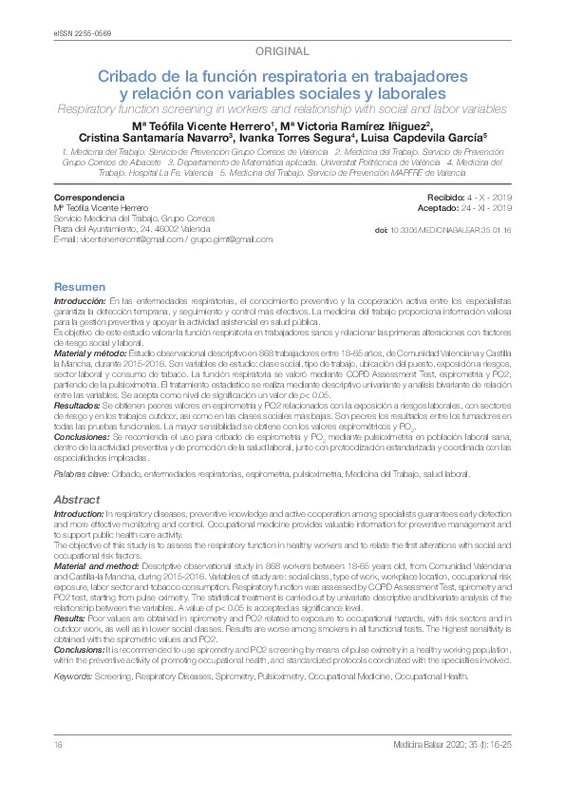JavaScript is disabled for your browser. Some features of this site may not work without it.
Buscar en RiuNet
Listar
Mi cuenta
Estadísticas
Ayuda RiuNet
Admin. UPV
Cribado de la función respiratoria en trabajadores y relación con variables sociales y laborales
Mostrar el registro sencillo del ítem
Ficheros en el ítem
| dc.contributor.author | Vicente Herrero, Mª Teófila
|
es_ES |
| dc.contributor.author | Ramírez Iñiguez, Mª Victoria
|
es_ES |
| dc.contributor.author | Santamaria Navarro, Cristina
|
es_ES |
| dc.contributor.author | Torres Segura, Ivanka
|
es_ES |
| dc.contributor.author | Capdevila García, Luisa
|
es_ES |
| dc.date.accessioned | 2021-03-10T04:31:20Z | |
| dc.date.available | 2021-03-10T04:31:20Z | |
| dc.date.issued | 2020-04 | es_ES |
| dc.identifier.uri | http://hdl.handle.net/10251/163578 | |
| dc.description.abstract | [ES] Introducción: En las enfermedades respiratorias, el conocimiento preventivo y la cooperación activa entre los especialistas garantiza la detección temprana, y seguimiento y control más efectivos. La medicina del trabajo proporciona información valiosa para la gestión preventiva y apoyar la actividad asistencial en salud pública. Es objetivo de este estudio valorar la función respiratoria en trabajadores sanos y relacionar las primeras alteraciones con factores de riesgo social y laboral. Material y método: Estudio observacional descriptivo en 868 trabajadores entre 18-65 años, de Comunidad Valenciana y Castilla la Mancha, durante 2015-2016. Son variables de estudio: clase social, tipo de trabajo, ubicación del puesto, exposición a riesgos, sector laboral y consumo de tabaco. La función respiratoria se valoró mediante COPD Assessment Test, espirometría y PO2, partiendo de la pulsioximetría. El tratamiento estadístico se realiza mediante descriptivo univariante y análisis bivariante de relación entre las variables. Se acepta como nivel de significación un valor de p< 0.05. Resultados: Se obtienen peores valores en espirometría y PO2 relacionados con la exposición a riesgos laborales, con sectores de riesgo y en los trabajos outdoor, así como en las clases sociales más bajas. Son peores los resultados entre los fumadores en todas las pruebas funcionales. La mayor sensibilidad se obtiene con los valores espirométricos y PO2 . Conclusiones: Se recomienda el uso para cribado de espirometría y PO2 mediante pulsioximetría en población laboral sana, dentro de la actividad preventiva y de promoción de la salud laboral, junto con protocolización estandarizada y coordinada con las especialidades implicadas. | es_ES |
| dc.description.abstract | [EN] Introduction: In respiratory diseases, preventive knowledge and active cooperation among specialists guarantees early detection and more elective monitoring and control. Occupational medicine provides valuable information for preventive management and to support public health care activity. The objective of this study is to assess the respiratory function in healthy workers and to relate the first alterations with social and occupational risk factors. Material and method: Descriptive observational study in 868 workers between 18-65 years old, from Comunidad Valenciana and Castilla-la Mancha, during 2015-2016. Variables of study are: social class, type of work, workplace location, occuparional risk exposure, labor sector and tobacco consumption. Respiratory function was assessed by COPD Assessment Test, spirometry and PO2 test, starting from pulse oximetry. The statistical treatment is carried out by univariate descriptive and bivariate analysis of the relationship between the variables. A value of p< 0.05 is accepted as significance level. Results: Poor values are obtained in spirometry and PO2 related to exposure to occupational hazards, with risk sectors and in outdoor work, as well as in lower social classes. Results are worse among smokers in all functional tests. The highest sensitivity is obtained with the spiromeiric values and PO2. Conclusions: It s recommended to use spirometry and PO2 screening by means of pulse oximetry in a healthy working population, the preventive activity of promoting occupational health, and standardized protocols coordinated with the specialties involved. | es_ES |
| dc.language | Español | es_ES |
| dc.publisher | Reial Acadèmia de Medicina de les Illes Balears | es_ES |
| dc.relation.ispartof | Medicina Balear (Online) | es_ES |
| dc.rights | Reconocimiento - No comercial - Sin obra derivada (by-nc-nd) | es_ES |
| dc.subject | Cribado | es_ES |
| dc.subject | Enfermedades respiratorias | es_ES |
| dc.subject | Espirometría | es_ES |
| dc.subject | Pulsioximetría | es_ES |
| dc.subject | Medicina del trabajo | es_ES |
| dc.subject | Salud laboral | es_ES |
| dc.subject | Screening | es_ES |
| dc.subject | Respiratory diseases | es_ES |
| dc.subject | Spirometry | es_ES |
| dc.subject | Pulsioximetry | es_ES |
| dc.subject | Occupational medicine | es_ES |
| dc.subject | Occupational health | es_ES |
| dc.subject.classification | MATEMATICA APLICADA | es_ES |
| dc.title | Cribado de la función respiratoria en trabajadores y relación con variables sociales y laborales | es_ES |
| dc.title.alternative | Respiratory function screening in workers and relationship with social and labor variables | es_ES |
| dc.type | Artículo | es_ES |
| dc.identifier.doi | 10.3306/MEDICINABALEAR.35.01.16 | es_ES |
| dc.rights.accessRights | Abierto | es_ES |
| dc.contributor.affiliation | Universitat Politècnica de València. Departamento de Matemática Aplicada - Departament de Matemàtica Aplicada | es_ES |
| dc.description.bibliographicCitation | Vicente Herrero, MT.; Ramírez Iñiguez, MV.; Santamaria Navarro, C.; Torres Segura, I.; Capdevila García, L. (2020). Cribado de la función respiratoria en trabajadores y relación con variables sociales y laborales. Medicina Balear (Online). 35(1):16-25. https://doi.org/10.3306/MEDICINABALEAR.35.01.16 | es_ES |
| dc.description.accrualMethod | S | es_ES |
| dc.relation.publisherversion | https://doi.org/10.3306/MEDICINABALEAR.35.01.16 | es_ES |
| dc.description.upvformatpinicio | 16 | es_ES |
| dc.description.upvformatpfin | 25 | es_ES |
| dc.type.version | info:eu-repo/semantics/publishedVersion | es_ES |
| dc.description.volume | 35 | es_ES |
| dc.description.issue | 1 | es_ES |
| dc.identifier.eissn | 2255-0569 | es_ES |
| dc.relation.pasarela | S\405090 | es_ES |








